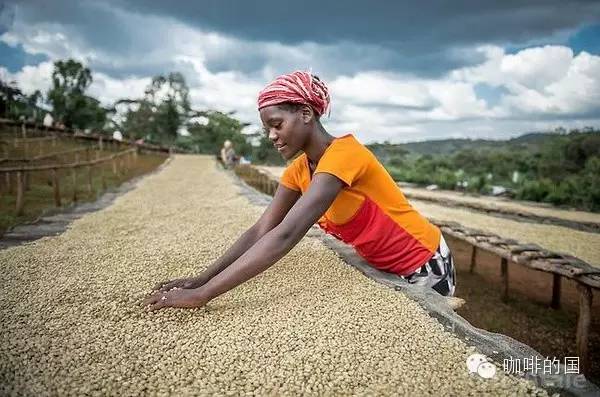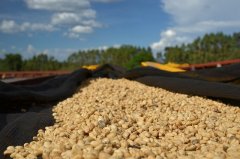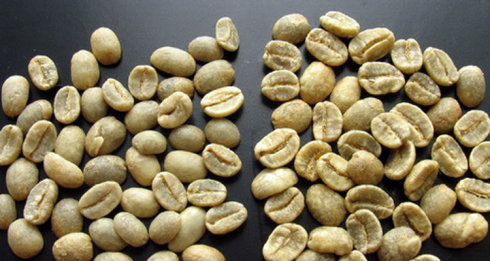What is Coffee Solar Coffee treatment method Coffee Bean Coffee treatment
Solarization is a traditional method of primary processing of coffee beans, and ancient coffee growing countries such as Ethiopia and Yemen still use solarization almost exclusively for raw beans.
Sun-drying begins by spreading tank-identified beans, ripe or semi-ripe, on a drying ground. The exact time depends on local climatic conditions, and generally takes two weeks to four weeks. When the moisture content of the coffee beans is reduced to 12%, then use a husker to grind off the dried pulp and silver skin.
Introduction to Green Coffee Bean Treatment--Solarization Method
Sunlight treatment is very demanding on the climate. If it rains during the sun, it will make the beans regain moisture and mold. Sun-dried beans are yellow when raw and brown in the center when baked, rather than white when washed. Sun-baked beans have a relatively better sweetness and body, and less sourness, but the quality is less stable and will have greater fluctuations. Solarization is widely used not only in Ethiopia and Yemen, but also in Africa and Indonesia, where Rochester coffee is grown because of its low cost.
Country: Ethiopia Fiscal year: 2003
Grade: G1
Production area: Gediyo
Altitude: 1900-2100 m
Treatment: Sunlight
Breed: Native species
Producer: Kebel Aricha
Flavor: Light fermented bouquet, sweet orange, spice, sweet honey
This batch of Yegashefi is produced at the Kebel Aricha processing plant, near about 650-700 small coffee farmers who bring ripe coffee berries to be processed and exchanged for cash. After the processing plant selects the available berries, they are placed directly on the shelf and exposed to the sun. They will be turned every 2-3 hours for the first few days to prevent excessive fermentation. After four to six weeks of sun exposure, depending on the weather and temperature, workers will remove the outer layer of pulp by machine and transport it to addis for storage. Sun-treated beans are usually stored in the form of shelled beans, which are not shelled until they are exported to ensure the quality of raw beans. This batch of sun-cured Arica is rated G1 by ECX, the highest rating. From green bean appearance, consistency, freshness to dry aroma and flavor, it is excellent. You can't miss it if you like bright acidity and strong berry flavor!
Flavor description: Light fermented wine aroma, dates, sweet orange tones, dark berry, lychee, carambola, peach, peach, longan, dates, honey sweet, cocoa with a little spice, body thick and lasting finish

Important Notice :
前街咖啡 FrontStreet Coffee has moved to new addredd:
FrontStreet Coffee Address: 315,Donghua East Road,GuangZhou
Tel:020 38364473
- Prev

Coffee Bean Processing Method Introduction Sunlight Coffee Bean Processing Method Ethiopia Sunlight Ye Jia Xue Fei
Solarization is a traditional method of primary processing of coffee beans, and ancient coffee growing countries such as Ethiopia and Yemen still use solarization almost exclusively for raw beans. Sun-drying begins by spreading tank-identified beans, ripe or semi-ripe, on a drying ground. The exact time depends on local climatic conditions, and generally takes two weeks to four weeks.
- Next

The difference between the two methods of tanning honey how to tell the difference between sunburn and sunburn is a traditional coffee.
Tanning is a traditional method for the initial processing of coffee beans, and at present, almost all coffee-growing countries such as Ethiopia and Yemen still use solarization to treat raw beans. Sun treatment will first identify sunken beans in the sink, that is, ripe or half-ripe beans are spread in the drying farm for natural drying. The specific time depends on the local climatic conditions, which usually takes two to four weeks.
Related
- What is the meaning of lactic acid fermentation with coffee bean treatment?
- How to judge the state of foam by sound?
- How does the latte pull out the unicorn pattern? Come to get for a little trick to improve the flower pull!
- Will flower pulling affect the taste of the latte?
- Do you know the history of coffee?
- The difference between honey treatment and sun washing what is raisin honey treatment?
- What kind of milk can a novice use to make coffee foam to keep the foam longer? The correct method and skills of milking tutorial sharing
- Why do washed coffee beans taste sour? Flavor characteristics of washed Coffee
- Introduction to the skill of how to practice the size and height of water injection around the circle of hand-brewed coffee
- How do beginners practice coffee flower drawing from scratch?

